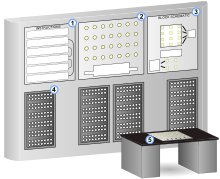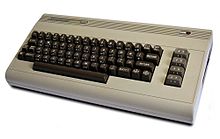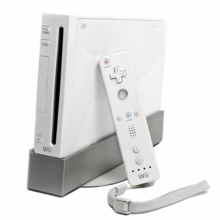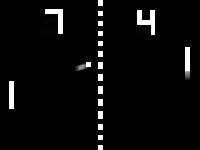History of video games


In the course of time, video games developed from technical experiments at universities in the 1950s to one of the most influential forms of recreational activities of the 21st century.
The beginnings
In 1946, the first computer game for a tube computer was developed by Thomas T. Goldsmith Jr. and Estle Ray Mann, and a patent was applied for on January 25, 1947. The patent was granted on December 14, 1948. In 1951 the mathematical Nim game was presented with the help of a NIMROD computer ; In 1952 there was the tic-tac-toe game OXO .
Tennis for Two at Brookhaven National Laboratory, which was constructed in 1958 by the American physicist William Higinbotham and consists of an analog computer and an oscilloscope , is usually regarded as the first video game.
Further development was heavily dependent on the further technical development of computer technology . This is how the first, graphically quite simple computer games were created on mainframes at American universities and were therefore reserved for only a small number of students and scientists, such as Spacewar! from 1962 at the Massachusetts Institute of Technology (MIT).
The 1970s
In the early 1970s, the existing mass-produced and therefore relatively inexpensive television technology developed into electronic gaming machines , which were also open to the public for the first time in coin-operated mode. Hence the name video game . The first successful game was Pong , by Atari founder Nolan Bushnell . He saw the game at a trade fair presentation by the game inventor Ralph Baer and developed it further. Unlike today, the machines were less likely to be found in amusement arcades, but - also accessible to children - in the entrances of supermarkets, cinemas, kiosks, chip shops, canteens or other public places. A game for one mark was normal.
During the 1970s, video games developed rapidly and were e.g. B. from companies like Atari or Magnavox in the form of video game consoles also more attractive for home users; as a result, the public arcades gradually lost their dominance in the field of video games. With the implementation of the very successful arcade game Space Invaders for the Atari 2600 , the breakthrough came in 1979 for home consoles, which quickly became mass-produced items.
The 1980s


With the introduction of the home and personal computer (PC), two technically separate types of video game developed for the time being: the console game (also called "video game") based on special game consoles and the computer game . In the beginning, computer games were mainly programmed for home computers such as the C64. The PCs designed primarily for serious applications with monochrome graphics and beeping loudspeaker sound were initially rather unsuitable for gaming. Only through improvements such as 16-color EGA graphics from 1984 and sound cards (e.g. Sound Blaster 1989) did the PC gradually become a competitor for home computers and consoles.
In 1983 the video game crash occurred : In North America, the market for game modules almost completely collapsed. While the video game industry had sales of $ 3 billion in 1982, that figure fell to $ 100 million in 1983. The reasons were:
- Flooding of the market with a high number of bad games (especially for the Atari 2600 )
- Unrealistic profit expectations of the mostly small manufacturing companies
- Superiority of home computers in terms of technology and possible applications
- Increasingly smaller price difference between console and home computer
- Light copyability of computer game s (see: Software piracy ) on cassettes and floppy disks , leading to higher appeal against the non-copyable for private modules of video games ( copy here was a competitive disadvantage , not an advantage, as is sometimes assumed - of course, the difference between console and software manufacturer must be mentioned.)
A new impetus for the video game industry came from Japan, whose video game market was dominated by domestic products and was therefore hardly affected by the American crash: Nintendo's 8-bit "Famicom" console, which appeared in 1983, was a great success after initial difficulties. When Nintendo Entertainment System (NES) modified it for the western market, Nintendo tested the interest of American consumers in the 1985 Christmas season. 50,000 consoles could be sold limited to the city of New York. As a result, the NES was introduced across North America in 1986 and Europe in 1987. But it was not until the publication of Super Mario Bros. (Japan 1985, North America 1986), which surpassed all video games published up to then in length and complexity, that a veritable "Nintendomania" triggered: The sales figures rose and a new era of video games began.
Most game genres have their origins in this era. Role playing games , racing games , jump 'n' runs , beat 'em ups , adventures and many other game categories were developed during this time.
In 1989, the Game Boy and the Atari Lynx were the first two handheld consoles with interchangeable modules to hit the market. The devices integrated a small, in the case of the Lynx, even colored LC display and control elements with the rest of the electronics in a handy housing.
The 1990s
In Europe there was a breakthrough of the so-called 16-bit consoles Super Nintendo Entertainment System (SNES) and Sega Mega Drive in the first half of the 1990s. These game consoles were extremely successful around the world. They offered gamers better graphics and better sound than the consoles and computer games of the 1980s. Another “handheld” console came onto the market with the Sega Game Gear .
Since the mid-1990s, the two video game areas for game consoles and PCs have been increasingly merged again for marketing reasons. Uniform storage media (such as the CD-ROM ) and compatible hardware made it possible to develop games for different consoles as well as for PCs in parallel and thus more cheaply and for a broader mass market.
The most important innovation in the console market was the switch from 2D to 3D graphics in the mid-90s with the help of the PlayStation , the Sega Saturn and the later released Nintendo 64 . The earlier consoles were able to display some 3D graphics, but only with the help of special graphics chips. 3D accelerator cards appeared for the first time on the PC. Although there were already less complex 3D graphics (e.g. in Doom , Duke Nukem 3D ) which were calculated by the CPU , the CPU could and can only calculate relatively simple 3D graphics in real time. The 3D support of the graphics cards later became indispensable. Later generations of graphics cards had both 2D and 3D support firmly integrated.
The first network-compatible games for the PC came on the market. This created new ways to play that were previously only rudimentary. Multiplayer games were mostly limited to two players, on the Nintendo 64 mostly to four players. With the PC, depending on the possibility, well over 10 players could now be included in a game. First strategy and role-playing games with network and online capabilities appeared.
At the end of 1998 a new generation of consoles was introduced with the Sega Dreamcast . The PlayStation 2 , the GameCube and the Xbox followed later . Sega's Dreamcast , with only 10 million units sold, would not live to see the end of this generation of consoles: Financially it barely escaped bankruptcy, the management of Sega decided to get out of the hardware business and converted from a console manufacturer to a pure software manufacturer.
The 2000s

The PlayStation 2 , which is downward compatible with its predecessor, was initially very popular . Far behind were the other 6th generation consoles .
Microsoft opened the 7th generation in 2005 with the Xbox 360 . In 2006 the Nintendo Wii and the PlayStation 3 from Sony followed. The devices are very different, for example in terms of hardware design and storage media, and were aimed at different target groups. Only the cheaper Wii, which has a controller with motion sensors, was commercially successful . The other two consoles have a 64-bit instead of 32-bit processor data bus, a graphics resolution in the HDTV standard as well as an optional hard drive and the option of playing DVD films or Blu-ray discs.
In the case of handhelds, the Nintendo DS (2004/2005) offered for the first time an additional screen as a touchscreen , a microphone for input and online capabilities. The Nintendo handheld received a hardware update in 2009 with the DSi. The latest version also offers two cameras and an SD card slot. The successor to the Nintendo DS, the Nintendo 3DS , was presented at an E3 trade fair. It can create a 3D effect without 3D glasses. The PlayStation Portable was particularly successful with optical media for the first time. The main platforms were / are:
- Sony PlayStation 2 (2000), 128 bit
- Nintendo GameCube (2001, 2002 in Europe), 128 bit
- Microsoft Xbox (2001, 2002 in Europe), 128 bit
7th generation:
- Microsoft Xbox 360 (2004), 256 bit
- Nintendo Wii (2006), 128 bit
- Sony PlayStation 3 (2006, 2007 in Europe), 256 bit
The 2010s
8th generation:
- Mobile platforms like Android , iOS and Windows Phone
- Nintendo 3DS (2011 in Europe, handheld)
- Sony PlayStation Vita (2012 in Europe, handheld)
- Nintendo Wii U (2012)
- Sony PlayStation 4 (2013)
- Microsoft Xbox One (2013)
- Nintendo Switch (2017)
The 2020s
The next generation game consoles offer 4K with 120fps, ray tracing and dare to take the first steps towards 8K gaming.
Most successful video games
The list of top hit computer games includes the computer and video games that have been sold, downloaded, and played the most.
timeline
| 1952 | AS Douglas programs the tic-tac-toe game OXO aka Noughts And Crosses with an EDSAC computer , the first computer game whose name is known. |
| 1958 | In October presents William Higinbotham with Tennis for Two , the first video game for two players. |
| 1962 | Stephen Russell develops Spacewar! for the PDP-1 . |
| 1967 | Ralph Baer builds the TV gaming display. |
| 1971 | Nolan Bushnell builds the Computer Space video game machine , which runs on Spacewar! is based. However, the game is still too complicated for the mass breakthrough. |
| Don Daglow programs baseball for the PDP-10 . | |
| 1972 | Nolan Bushnell and Ted Dabney found Atari . |
| Pong will be on sale from November. | |
| Magnavox releases the first game console, Odyssey . | |
| The amateur cave explorer William Crowther programmed a previous version of the first text-based adventure game Adventure ; the program is intended as a simple caving simulation, not a game in the strict sense. | |
| Gregory Yob programs the game Hunt the Wumpus . | |
| 1973 | The slot machine Elepong is published by Taito. |
| Midway licenses Pong and sells it under the name Winner. | |
| 1975 | Midway releases the Gun Fight slot machine with a microprocessor. |
| Don Daglow programs the Proto-RPG Dungeon for the PDP-10 . | |
| Don Woods adds various fantasy elements to William Crowthers cave exploration simulation ; the result is Adventure , the first real adventure game . | |
| a home version of Pong is released. | |
| 1976 | The Apple I is successfully launched. |
| Fairchild is selling the first programmable, module-based game console, Fairchild Channel F, in November. | |
| 1977 | The Video Computer System (VCS) from Atari is released in the US on September 11. |
| The Apple II comes onto the market. | |
| Commodore presents the programmable Personal Electronic Transactor (PET). | |
| RadioShack introduces the TRS-80 home computer. | |
| Zork is being programmed. | |
| 1978 | Taito’s Space Invaders slot machine is sold successfully around the world. |
| Roy Trubshaw develops the first online game at the University of Essex . | |
| The Philips G7000 appears. | |
| 1979 | Richard Garriott programs Akalabeth , the forerunner of the Ultima series . |
| 1980 | Pac-Man becomes the best-selling video game to date. |
| Space Invaders appears for the Atari VCS. | |
| With the Game & Watch series, Nintendo publishes the first successful handheld console series. | |
| 1981 | Commodore releases the VC 20 . |
| The arcade game Donkey Kong , designed by Shigeru Miyamoto , appears in which Jumpman appears for the first time , who later becomes a cult under the name Super Mario . | |
| IBM launches the first PC . | |
| 1982 | Commodore brings the C64 onto the market. |
| Don Daglow programs the proto-sim game Utopia for the Intellivision . | |
| 1983 | Sega releases the SG 1000 game console . |
| Nintendo releases the Famicom game console in Japan . | |
| Atari releases the 600XL and 800XL computers. | |
| Electronic Arts publishes first games for the Atari 2600 and the Apple II . | |
| Atari is making a big loss. | |
| The console games market has practically collapsed (see Video Game Crash ), the computer games market is booming. | |
| 1984 | The game The Eidolon, which can be seen as the first first-person shooter , is developed by Lucasfilm Games, (now LucasArts ) for the Atari 8-bit and the Commodore 64 . |
| 1985 | Nintendo releases the Nintendo Entertainment System (NES) in the US and Europe. |
| Nintendo is releasing the Super Mario Bros. game for the NES in Japan , which is still the best-selling platform game to this day. (approx. 42 million units sold). | |
| Atari releases the Atari 520 ST . | |
| 1986 | Nintendo publishes the first part of the The Legend of Zelda series . |
| 1987 | Commodore releases the Amiga 500 . |
| LucasArts publishes the computer game Maniac Mansion . | |
| Square , close to bankruptcy, saves itself with the start of the Final Fantasy series . | |
| 1989 | Sega launches Sega Mega Drive . |
| Nintendo released the Game Boy in Japan and the USA (1990 in Europe). | |
| Atari releases the Atari Lynx . | |
| 1990 | Nintendo releases the Super Nintendo Entertainment System (SNES) . |
| 1991 | Sid Meier's Civilization appears. |
| Don Daglow and Cathryn Mataga program the proto-MMORPG Neverwinter Nights for AOL . | |
| 1992 | Dune II - Fight for Arrakis appears and heralds the era of modern real-time strategy games. |
| 1993 | Doom from id Software appears. |
| Commodore publishes the CD³² . | |
| Atari releases the Atari Jaguar . | |
| 1994 | Sony released the PlayStation in Japan, 1995 in Europe and America. |
| The Electronic Entertainment Expo takes place for the first time. | |
| 1995 | Tomb Raider from Eidos appears. |
| 1996 | Nintendo launches the Nintendo 64 in Japan and the USA (1997 in Europe). |
| Nintendo is releasing the first offshoots of the Pokémon series with Pokémon Red and Blue . | |
| 1997 | Ultima Online , one of the first graphically sophisticated MMORPGs , starts. |
| 1998 | Sega launches the Dreamcast . |
| The Legend of Zelda: Ocarina of Time , the game with the highest rating to date with a Metascore of 99 out of 100 points, appears for the N64. | |
| 2000 | Sony launches the PlayStation 2 , the best-selling game console to date. |
| 2001 | Nintendo releases the Nintendo GameCube . |
| Microsoft releases the Xbox . | |
| 2004 | World of Warcraft , the most successful MMORPG to date , is published. |
| 2004 | Nintendo released the Nintendo DS , the best-selling handheld console to date. |
| Sony releases the PlayStation Portable . | |
| 2005 | Microsoft releases the Xbox 360 . |
| 2006 | Nintendo releases the Wii . |
| Sony releases the PlayStation 3 . | |
| 2009 | League of Legends , the most played game to date, is released. |
| 2011 | Nintendo releases the Nintendo 3DS , the first portable console that enables autosterescopic 3D without glasses. |
| Sony will release the PlayStation Vita in Japan at the end of December and in Europe and the US in February 2012. | |
| 2012 | Nintendo released the Wii U . |
| 2013 | Sony and Microsoft are launching their two new consoles, PlayStation 4 and Xbox One , at almost the same time . |
| 2016 | The HTC Corporation introduces the HTC Vive before a virtual reality goggles for the PC. |
| Oculus releases the first consumer version of the Oculus Rift for the computer. | |
| Sony releases the PlayStation VR exclusively for the PlayStation 4. | |
| Sony and Microsoft bring their PlayStation 4 Pro and Xbox One S enhanced consoles onto the market. | |
| 2017 | Nintendo released their new hybrid console, the Nintendo Switch . |
| Microsoft releases its new console, the Xbox One X , the "most powerful console in the world" to date. |
See also
Computer Games Museum

The Computer Games Museum Berlin , which opened the world's first permanent exhibition on digital interactive entertainment culture in 1997, is showing “Computer games. Evolution of a medium ”, with 300 exhibits, a historical outline of the development of the digital game.
literature
- Natascha Adamowsky (Ed.): Digital Modernism. Matthias Zimmermann's model worlds . Hirmer Verlag, Munich 2018, ISBN 978-3-7774-2388-3
- Winnie Forster : Game consoles and home computers 1972–2009 . 3rd edition, Utting: Gameplan, 2009, ISBN 978-3-00-024658-6
- Stephan Schwingeler (Ed.): The space machine. Space and perspective in computer games . VWH Verlag, Boizenburg 2008, ISBN 978-3-940317-24-7
- Steven L. Kent: The Ultimate History of Video Games . Roseville / California: Prima, 2001, ISBN 0-7615-3643-4
- Konrad Lischka: Playground Computer. Culture, history and aesthetics of the computer game . Hannover: Heise, 2002, ISBN 3-88229-193-1
- Claus Pias: Computer game worlds . Munich: Sequenceia, 2002, ISBN 3-936488-09-6
- Steven L. Kent: The First Quarter: A 25-Year History of Video Games . BWD Press, 2000, ISBN 978-0-9704755-0-3
DVD
- Video Game Invasion - The history of a global obsession , 60 minutes, 2005.
Web links
- Link catalog on the history of video games at curlie.org (formerly DMOZ )
- The history of video games
- The complete history of PC and video games from Games Aktuell
- Virtual tour through the history of video games
- Lexigame.de Classic video games
- RETROBASE.NET Extensive database of classic video games
- Videogame Archive , University of Texas at Austin
- Classic zone
Individual evidence
- ^ Pong story
- ^ Nimrod computer
- ↑ History of home computers - The year 1983 ( Memento of the original from October 16, 2007 in the Internet Archive ) Info: The archive link was automatically inserted and not yet checked. Please check the original and archive link according to the instructions and then remove this notice.
- ↑ David Sheff: Game Over . GamePress / CyberActive 1999. pp. 149, 150. ISBN 0-9669617-0-6 (English).
- ↑ David Sheff: Game Over . GamePress / CyberActive 1999. p. 169. ISBN 0-9669617-0-6 .
- ↑ Chris Kohler: Power Up . Indianapolis, Indiana 2004, ISBN 0-7440-0424-1 , Coming Home section : Super Mario Bros. pp. 54-63.
- ↑ The Legend of Zelda: Ocarina of Time. Retrieved April 21, 2019 .
- ↑ League Of Legends: The most played PC game worldwide . In: PC GAMES . ( pcgames.de [accessed on January 23, 2017]).
- ↑ Xbox One X: Microsoft announces price and release date - SPIEGEL ONLINE. Retrieved April 21, 2019 .

